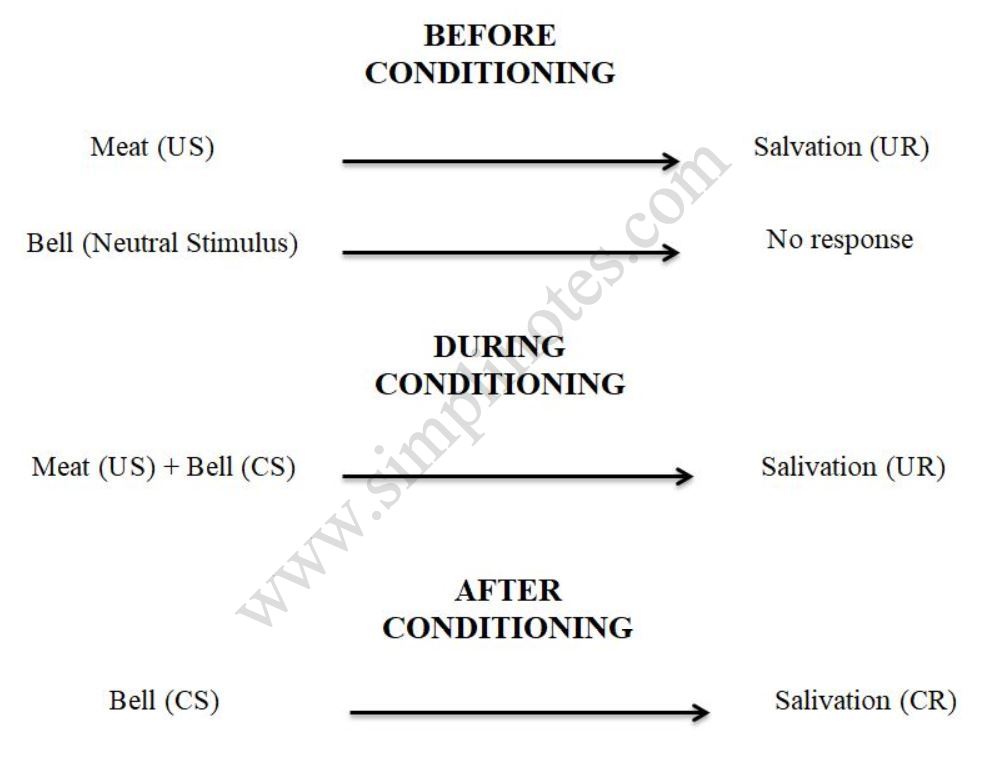Learning Theories
Learning theories explain how learning takes place. Many psychologists and behavioural scientists have developed different theories of learning. The most widely accepted theories are as follow:
A. Conditioning Theory
Conditioning is the process in which an ineffective object or situation becomes so much effective that it makes the hidden response apparent in the absence of this stimulus, hidden response is a natural or normal response. This is based on the premise that learning is establishing association between response and stimulus. Conditioning has two main theories:
1. Classical Conditioning
Classical conditioning states that behaviour is learned by repetitive association between a stimulus and a response (S-R association) Jrhe organism learns to transfer a response from one stimulus to a previously neutral stimulus! Four elements are always present in classical conditioning. These are:
i. Unconditioned stimulus (US)—like food which invariably causes to react in a certain way, i.e., salivation.
ii. Unconditioned response (UR)—takes place whenever the US is presented, that is, whenever the organism (dog in the original experiment) is given food (US), it salivates.
iii. Conditioned stimulus (CS)—the object that does not initially bring about the desired response like the sound of the bell.
iv. Conditioned response (CR)—a particular behaviour that the organism learns to produce S to the CS, that is, salivation.
Classical conditioning is result of the experiments on dogs done by Ivan Pavlov, a Russian Psychologist. In his experiments he linked the conditioned stimulus with unconditioned stimulus. Pavlov proposed that the dog would salivate if meat was given to him; meat was an unconditioned or reflexive, response. Pavlov rang the bell at the time when he gave dog meat. The bell alone brought no response in terms of salivation by the dog, because he had no prior experience of associating food (meat) with bell, but constant connection among the two established in the mind of the dog. After few trials dog started associating meat with the bell, he would salivate even when just the bell rang, and no meat was given Now the bell turned into a conditioned stimulus, called as newly learnt or conditioned response (CR). Pavlov went beyond the simple conditioning of his dogs to salivate to the sound of the bell. He next paired a black square with the bell. After a number of trials with this pairing, the dogs salivated to the black square alone. The original conditioned stimulus (bell) had become a reinforcing unconditioned stimulus for the new conditioned stimulus (black square). This was called second-order conditioning. Pavlov could go for third-order conditioning but not more. However, most behavioural scientists agree that human beings are capable of being conditioned higher than the third order. Classical conditioning, as discussed above, is presented below:
- Classical conditioning has some important implications for understanding human behavior. Classical conditioning was initially discovered to be an effective method of learning in dogs. Since that time, numerous research studies have found classical conditioning to be effective in humans as well.
There are hundreds of examples in our daily lives that show how classical conditioning affects us. Classical conditioning is used in advertisements, learning and treating fears or phobias, reinforcement of good behaviors, and even to help protect you, like against poisons or certain foods. It can also help in pet training. Advertising is a field where classical conditioning is used the most. Companies’ use various models for this purpose e.g. cartoon characters are used in commercials of those products which are associated with kids. In the same way, female models are used in those ads in which products are associated with females or housework. Similarly sports personalities for products associated with men.
Classical conditioning helps in learning process. Classical conditioning can be an elicited response to specific identifiable event. For example, a manager gives good news to the executive whenever he called him in his room (US). After few such occasions he started associating the call to meet in his room with some good news. Therefore, he becomes happy whenever he is called in the managers’ room.
Simple reflexive behavior can be changed by classical conditioning. But the complex behavior of the individuals in organization is not selected and it is voluntary behavior rather than reflexive. Classical conditioning relies on simple cause and effect relationships between one stimulus and one response. It cannot explain the behavior by which people choose one course of action over other.
Merits
i. The theory of classical conditioning suggests that human beings also are capable of being conditioned by the first order, second order, third order and so on. It teaches that learning can be transferred to stimuli other than those used in the original conditioning. Again, a conditioned stimulus can have a reinforcing effect under higher-order conditioning. So the theory provides an explanation for the important role of secondary rewards in organizational behaviour. For instance, money acts as a stimulus because it constitutes power to buy necessaries like food, cloth and other materials. When fringe benefits are offered in addition to salary, they have a reinforcing effect on the behaviour of employees.
Limitations
i. Classical conditioning represents only a part of the human learning process. As Skinner pointed out, it explains only respondent (reflexive) behaviour. This is just involuntary response. But most human behaviour is related to the environment. That is why more money does not always lead to better response.

